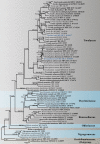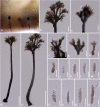Multigene phylogeny and taxonomy of Dendryphion hydei and Torula hydei spp. nov. from herbaceous litter in northern Thailand
- PMID: 32023268
- PMCID: PMC7001993
- DOI: 10.1371/journal.pone.0228067
Multigene phylogeny and taxonomy of Dendryphion hydei and Torula hydei spp. nov. from herbaceous litter in northern Thailand
Abstract
During our studies on asexual fungi colonizing herbaceous litter in northern Thailand, we discovered two new fungal species, viz. Dendryphion hydei and Torula hydei spp. nov. The latter are examined, and their morphological characters are described as well as their DNA sequences from ribosomal and protein coding genes are analysed to infer their phylogenetic relationships with extant fungi. Torula hydei is different from other similar Torula species in having tiny and catenate conidia. Dendryphion hydei can be distinguished from other similar Dendryphion species in having large conidiophores and subhyaline to pale olivaceous brown, 2-4(-5)-septate conidia. Multigene phylogenetic analyses of a combined LSU, SSU, TEF1-α, RPB2 and ITS DNA sequence dataset generated from maximum likelihood and Bayesian inference analyses indicate that T. hydei forms a distinct lineage and basal to T. fici. Dendryphion hydei forms a distinct lineage and basal to D. europaeum, D. comosum, D. aquaticum and D. fluminicola within Torulaceae (Pleosporales, Dothideomycetes).
Conflict of interest statement
NO authors have competing interests.
Figures



Similar articles
-
Morphology and multi-gene phylogeny reveal a novel Torula (Pleosporales, Torulaceae) species from the plateau lakes in Yunnan, China.Biodivers Data J. 2023 Aug 30;11:e109477. doi: 10.3897/BDJ.11.e109477. eCollection 2023. Biodivers Data J. 2023. PMID: 37693696 Free PMC article.
-
Pleocatenatachiangraiensis gen. et. sp. nov. (Pleosporales, Dothideomycetes) from medicinal plants in northern Thailand.MycoKeys. 2022 Feb 11;87:77-98. doi: 10.3897/mycokeys.87.79433. eCollection 2022. MycoKeys. 2022. PMID: 35210923 Free PMC article.
-
Tubeufia asiana, the teleomorph of Aquaphila albicans in the tubeufiaceae, pleosporales, based on cultural and molecular data.Mycologia. 2007 Nov-Dec;99(6):884-94. doi: 10.3852/mycologia.99.6.884. Mycologia. 2007. PMID: 18333512
-
Introducing a new pleosporalean family Sublophiostomataceae fam. nov. to accommodate Sublophiostoma gen. nov.Sci Rep. 2021 May 4;11(1):9496. doi: 10.1038/s41598-021-88772-w. Sci Rep. 2021. PMID: 33947898 Free PMC article.
-
Lignicolous freshwater ascomycota from Thailand: Phylogenetic and morphological characterisation of two new freshwater fungi: Tingoldiago hydei sp. nov. and T. clavata sp. nov. from Eastern Thailand.MycoKeys. 2020 Mar 26;65:119-138. doi: 10.3897/mycokeys.65.49769. eCollection 2020. MycoKeys. 2020. PMID: 32269482 Free PMC article.
Cited by
-
New Species, New Record, and Antagonistic Potential of Torula (Torulaceae, Pleosporales) from Jilin Province, China.Microorganisms. 2025 Jun 23;13(7):1459. doi: 10.3390/microorganisms13071459. Microorganisms. 2025. PMID: 40731969 Free PMC article.
-
Multigene phylogeny, taxonomy, and potential biological properties of Pseudoroussoella and Neoroussoella species (Roussoellaceae, Dothideomycetes) from Asteraceae weeds in northern Thailand.MycoKeys. 2024 Dec 17;111:129-146. doi: 10.3897/mycokeys.111.136922. eCollection 2024. MycoKeys. 2024. PMID: 39723168 Free PMC article.
-
Morphology and multi-gene phylogeny reveal a novel Torula (Pleosporales, Torulaceae) species from the plateau lakes in Yunnan, China.Biodivers Data J. 2023 Aug 30;11:e109477. doi: 10.3897/BDJ.11.e109477. eCollection 2023. Biodivers Data J. 2023. PMID: 37693696 Free PMC article.
-
Taxonomy and Phylogeny of Novel and Extant Taxa in Pleosporales Associated with Mangifera indica from Yunnan, China (Series I).J Fungi (Basel). 2022 Feb 1;8(2):152. doi: 10.3390/jof8020152. J Fungi (Basel). 2022. PMID: 35205906 Free PMC article.
-
The Plant Family Asteraceae Is a Cache for Novel Fungal Diversity: Novel Species and Genera With Remarkable Ascospores in Leptosphaeriaceae.Front Microbiol. 2021 May 13;12:660261. doi: 10.3389/fmicb.2021.660261. eCollection 2021. Front Microbiol. 2021. PMID: 34054759 Free PMC article.
References
-
- Sturm J. Deutschlands Flora, Abt. III. Die Pilze Deutschlands. 1829; 2: 1–136.
-
- Bhat DJ. Fascinating Microfungi (Hyphomycetes) Of Western Ghats-India. Department of Botany. Goa University; 2017.
-
- Crous PW, Shivas RG, Quaedvlieg W, van der Bank M., Zhang Y, Summerell BA, et al. Fungal Planet description sheets: 214–280. Persoonia. 2014; 32(1):184–306. http://doi: 10.3767/003158514X682395 - PMC - PubMed
-
- Hyde KD, Hongsanan S, Jeewon R, Bhat DJ, McKenzie EHC, Jones EBG, et al. Fungal diversity notes 367–490: taxonomic and phylogenetic contributions to fungal taxa. Fungal Divers. 2016; 80:1–270. 10.1007/s13225-016-0373-x - DOI
-
- Li JF, Phookamsak R, Jeewon R, Bhat DJ, Mapook A, Camporesi E, et al. Molecular taxonomy and morphological characterization reveal new species and new host records of Torula species (Torulaceae, Pleosporales). Mycol Prog. 2017; 16:447–461. https://doi: 10.1007/s11557-017-1292-2
Publication types
MeSH terms
Substances
LinkOut - more resources
Full Text Sources
Miscellaneous

